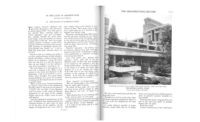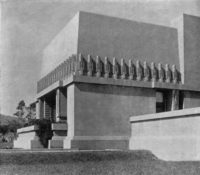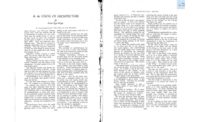A cast-block building: such massing as is felt to be adequate to the sense of block and box and slab; more freedom in spacing.
The purely or physically plastic structure: center line of thin webbing with a flesh-covering on either side; unit-system may be abandoned.
Then there are the double-wall constructions requiring great kill in spacing so that the interior shell will work simply with the outer shell. And there are as many others as there are combinations of all these.
But the more simple the materials used – the more the building tends toward a mono-material building – the more nearly will “perfect style” reward an organic plan and ease of execution economize results. The more logical will the whole become.
A wood plan is seen in the plan for the Coonley house at Riverside, see page 52, and in the plan for “D101 house”
A cast-block and slab building: the plan for Unity Temple at Oak Park, (page 54).
Brick plans: the plan for the D.D. Martin residence at Buffalo, (page 53) and the Ullman house at Oak Park, Illinois, (page 55).
A steel-and-glass plan for a skyscraper, concrete supports and floor slabs: this plan will be used later in this series to illustrate another article.
The purely “plastic” structure may be seen in the “Einstein Tower” by Mendelsohn and buildings by European Modernists.
A double-wall construction, in this case of pre-cast blocks is seen in the Ennis house at Hollywood, (page 56).
A thin concrete slab-structure: the merchandise building at Los Angeles.
In the matter of building methods. These too are meantime shaping the plan. In the Coonley house – the 4’0” unit works with 16” centers as established in carpenter practice for the length of lath, the economical spacing of studs and nailing-bearings, standard lumber lengths.
In Unity Temple – the only limit was the mass of concrete that could withstand the violent changes of climate and remain related to human scale and easy construction. The box and blocks, however, determine the shape of every feature and every detail of the features, as it was all cast in “boxes.” So a unit suitable for timber construction was adopted as the false-work in which it was cast was made of lumber. Multiples of 16”, syncopated, was the scale adopted.
In the Martin house, brick was used. Brick lends itself to articulation in plan and is an easy material to use architecturally. Bricks naturally make corners and the corners are easily used for play of light and shade. The Martin house is an organized brick-pier building. It is when assembling groups of piers in rhythmical relation to the whole that brick comes out best according to its nature. A 7’-9” unit reduced by minor mullions to 3’-9”, was used, in the horizontal only. There are other views of brick as legitimate as this one, to be used according to the individual “taste” of the designer. The broken masses of textured walls, for instance.
In the steel-and-glass building there are no walls. The method yields best to suspended screens, shop-fabricated. A mechanized fabric enters here to give the form and style that is architecture. The structural supports and floor-slabs in this case happen to be concrete. They could be protected steel as well. Planned on a 4’-0” unit, emphasis on alternate verticals. No emphasis on horizontals.
In the pre-cast-block building, the method of building wholly determines the form and style. This is a mono-material structure planned on multiples of 16” inches square both horizontal and vertical. No emphasis.
The slab-building is an expression of another method. Cast-slabs, set sidewise and lengthwise, and flatwise, making everything, as may be seen in the result. Planned on multiples of 7’-0”.
Concerning articulation. The Ennis house will serve to illustrate the principle which, once grasped, is simple.
In the building, each separate portion of the building devoted to a special purpose asserts itself as an individual factor in the whole.
The dining-room associated with terraces is one mass. The living-room with bedroom attached, another mass standing at the center on a terrace of its own – the dominating feature of the group.
Mr. Ennis’s bedroom, semi-detached and used as a study or office, is another and terminal mass.
At the rear is the kitchen unit, a subordinate mass. All are connected by a gallery passing along the group at the areas. Finally the terrace-wall ends in a detached mass to the rear of the lot – the garage and chauffeur’s quarters.
A little study will show how each separate room makes its own characteristic contribution to the whole mass.
The completed whole crowns the end of a high ridge in Hollywood and is a pre-cast slab-block building woven together with steel.
These articulations are as obvious in the plan as in the perspective. The Coonley house is similarly articulate.
Articulate buildings of this type have their parallel in the music of Bach particularly, but in any of the true form-masters in music.
It may be readily seen that in this particular direction lies indefinite variety in expression. The sense of it is fundamental in any architectural release.
In the matter of expression and style.
As a matter of logic in the plan it is easy to see there can be none except as the result of scale, materials and building method. But with all that properly set, there is the important human equation at work in every move that is made. The architect weaves into it all his sense of the whole. He articulates –emphasizes what he loves.
No matter how technically faithful his logic may have been to his scale and materials and method – over and above all that, living in the atmosphere created by the orchestration of those matters, hovers the indefinable quality of style. Style emanating from the form, as seen by the man himself. And while it speaks to you of all those important matters, it leaves you imbued by dignity, grace, repose, gaiety, strength, severity, delicacy and of rhythmical order, in a musical sense, as the master wills – just as music does. Usually you hear music as you work. But not necessarily.
So every true building is of the quality of some man’s soul, his sense of harmony and “fitness,” which is another kind of harmony – more or less manifest in the fallible human process.
And his building will nobly stand, belonging to its site – breathing this message to the spirit quite naturally, so long as his work was well done or the course of human events does not inundate or human ignorance willfully destroy his building.







